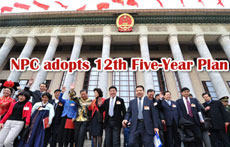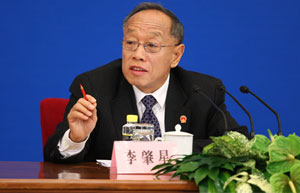Full Text: Report on the Work of the Government
(Xinhua)
Updated: 2011-03-15 14:07
Third, we worked to balance regional economic development. We implemented a master strategy for regional development, issued and implemented the national plan for development priority zones; formulated new 10-year guidelines for the large-scale development of the western region and a number of regional development plans; and introduced new measures to stimulate development by leaps and bounds in Tibet, Tibetan ethnic areas in Sichuan, Yunnan, Gansu and Qinghai provinces, Xinjiang and other ethnic minority areas. Development accelerated in the central and western regions and northeast China, and their economic growth rates and other main economic indicators were higher than the national average. The economic structure of the eastern region constantly improved, and its innovativeness and competitiveness gradually increased. Discrepancies in levels of basic public services among regions were decreasing, and the development of each region was taking on unique characteristics.
4. Determinedly working to deepen reform and opening up, and strengthening the internal vitality of economic and social development
We gradually improved the system of transfer payments and set up a rudimentary mechanism for ensuring basic funding for county-level governments. We comprehensively carried out VAT reform. The reform of prices of refined oil products and related taxes and fees was implemented smoothly. Trials were launched for the reform of resource taxes, and the corporate tax systems for domestic and overseas-funded enterprises were unified. The reform to convert large state-owned commercial banks to stockholding companies was smoothly completed, and the reform of policy-based financial institutions and rural credit cooperatives is well underway.
We steadily resolved the issue of floating non-tradable shares of listed companies; successfully launched the ChiNext stock market; and introduced stock index futures and securities margin trading. The market for government bonds developed steadily. We deepened the reform and opening up of the insurance industry. Orderly progress was made in reforming the mechanism for setting the RMB exchange rate, and the trials of settling cross-border trade accounts in RMB were constantly expanded. Positive progress was made in the reform to turn state-owned enterprises (SOEs) into stockholding corporations and the reform of the system for managing and overseeing state assets. We accelerated reform of the postal system. A series of policies were formulated and implemented to promote the development of small and medium-sized enterprises and encourage nongovernmental investment, the environment for the development of the non-public sector of the economy constantly improved, and economic entities under diverse forms of ownership developed side by side.
The breadth and depth of our openness to the outside world constantly increased. Total import and export volume grew by an average annual rate of 15.9 percent, and the structure of imports and exports constantly improved. Our trade surplus decreased for two consecutive years, and the year-on-year decrease was 6.4 percent in 2010. The utilization of foreign capital further improved. The pace of enterprises "going global" increased noticeably: outward foreign direct investment reached $220 billion and the total volume of contracts to build foreign projects and provide overseas labor services reached $335.2 billion. We energetically participated in the reform of global economic governance and the development of mechanisms for regional cooperation, and our multilateral and bilateral economic and trade cooperation continued to deepen. The scale of our foreign aid continued to grow. Opening to the outside world strongly stimulated economic development and restructuring, increased employment, attracted advanced technology and managerial expertise, and greatly improved China's international standing.



